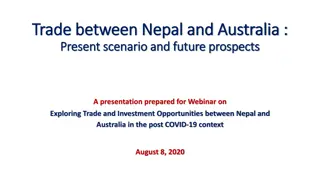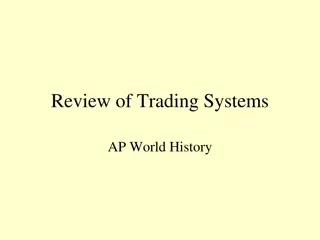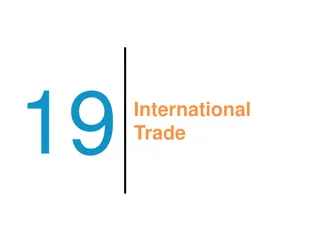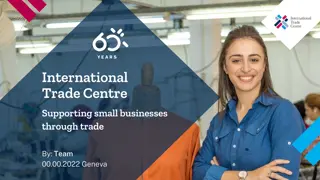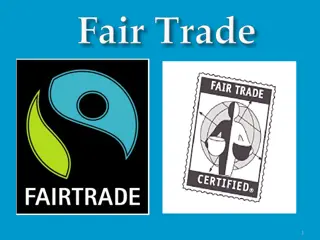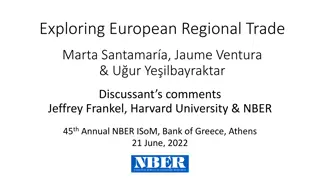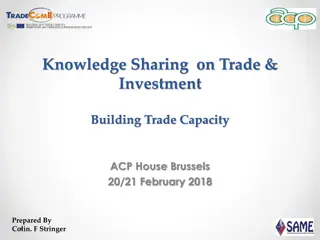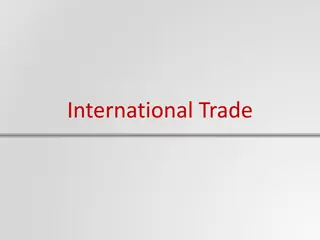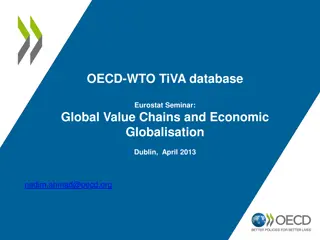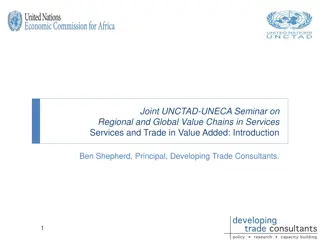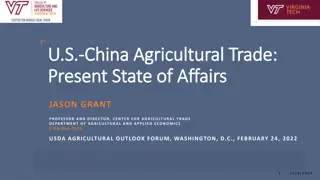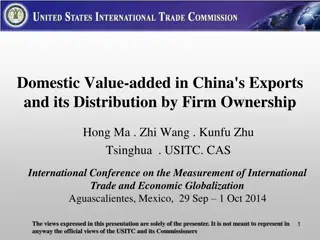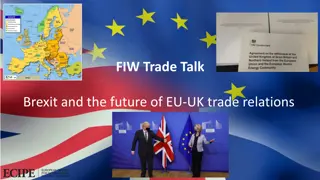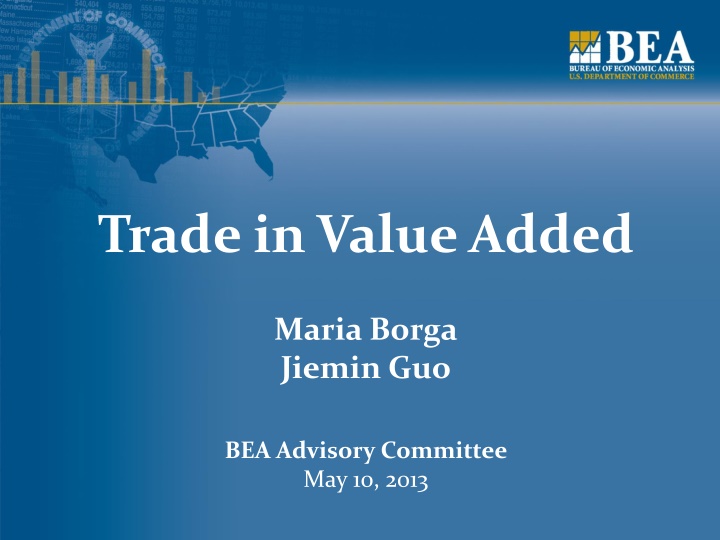
Trade in Value Added
Explore the concept of Trade in Value Added (TiVA) and its implications in global trade dynamics. Learn about value chains, gross vs. value-added basis, measuring TiVA, and studies analyzing TiVA measures.
Download Presentation

Please find below an Image/Link to download the presentation.
The content on the website is provided AS IS for your information and personal use only. It may not be sold, licensed, or shared on other websites without obtaining consent from the author. If you encounter any issues during the download, it is possible that the publisher has removed the file from their server.
You are allowed to download the files provided on this website for personal or commercial use, subject to the condition that they are used lawfully. All files are the property of their respective owners.
The content on the website is provided AS IS for your information and personal use only. It may not be sold, licensed, or shared on other websites without obtaining consent from the author.
E N D
Presentation Transcript
Trade in Value Added Maria Borga Jiemin Guo BEA Advisory Committee May 10, 2013
Globalization and Measurement of Trade May 2011 Advisory Committee: Global Manufacturing & Measurement Issues Raised by the IPhone Trade in goods in the ITAs measured on a gross basis Full value attributed to the country the transaction is with Global value chains Goods that cross borders multiple times for further processing are counted multiple times Measured on a value added basis Remove domestic content of imports/foreign content of exports Value added attributed to the country that is its source 2 2
Gross vs. Value Added Basis Trade Exports Imports Balance Gross basis Domestic VA that stays overseas + Foreign VA that stays home + Domestic VA that stays overseas - Foreign VA that stays home Domestic VA that will return home in imports + Domestic VA that is embedded in imports + Foreign VA that is embedded in exports Foreign VA that will be embedded in exports Value added basis Domestic value added that stays overseas Foreign value added that stays home Domestic VA that stays overseas - Foreign VA that stays home 3 3 (Benedetto 2012)
How to Measure Trade in Value Added (TiVA) Case studies IPod, IPhone, IPad, and Barbie Cannot be done for all products Identifies only country of the first link in the chain Input Output (I-O) approach Use national I-O tables and bilateral merchandise trade statistics by end use category Create links between exports in one country and use as intermediate inputs or final demand in importing country Direct measurement Surveys 4 4
Studies of TiVA Measures Koopman, Powers, Wang, and Wei (2010), Give Credit Where Credit is Due: Tracing Value Added in Global Production Chains Johnson and Noguera (2012), Accounting for Intermediates and Trade in Value Added Maurer and Degain (2010), Globalization and Trade Flows: What You See Is Not What You Get Meng, Fang, and Yamano (2012), Measuring Global Value Chains and Regional Economic Integration: An International Input-Output Approach WTO and OECD Trade in Value Added Database 5 5
Results from Recent Studies Koopman, Powers, Wang, and Wei (2010) Built their own global Inter-Country I-O table 26 countries and 41 sectors Treated China processing and Mexico processing as separate exporters from China and Mexico for domestic production 41% decrease in U.S. trade deficit with China in 2004 40% increase in U.S. trade deficit with Japan in 2004 6 6
Results from Recent Studies (Continued) OECD-WTO TiVA database Global I-O table covers 57 countries and 37 industries The database publishes results for 40 countries and 18 industries due to concerns about quality of the underlying data 25% decrease in U.S. trade deficit with China in 2009 60% increase in U.S. trade deficit with Japan in 2009 7 7
Insights Gained from TiVA Measures Place in global value chains Countries upstream in value chains produce inputs used by other countries Bilateral trade issues/policies Countries may have persistent trade surpluses due to position at end of global value chain Anti-dumping and other trade measures may adversely affect domestic producers of intermediate inputs Revealed comparative advantage Gross flows may distort 8 8
Limitations of TiVA Data and methods for measurement of TiVA Inconsistent international trade statistics Timeliness and level-of-detail of national I-O accounts used to construct international I-O tables varies Detailed I-O tables often have long time lags but being used to study current global value chains Reliance on mechanical procedures to balance statistics and allocate imports to using industries ( proportionality assumption) 9
BEA I-O Accounts BEA publishes Benchmark and Annual I-O accounts Benchmark (500 industries/products): based on Economic Census; 2007 Benchmark to be published in December, 2013 Annual (65 industries/products): time series for 1998-2011 U.S. I-O accounts are incorporated in these international I-O tables used in measuring TiVA However, these international I-O tables offer much less industry detail than available in United States 10
BEAs I-O Accounts Can Be Used to Estimate U.S. TiVA U.S. domestic value-added share of gross exports and foreign import share of gross imports on a bilateral basis Use greater industry/product detail Aggregate data and mechanical updating procedures can bias estimates for import use by industries But cannot trace value added beyond immediate supplier Use data on import use by industry New data collections and data linking by the Census Bureau could provide independent estimates of import use by industry BEA and CES research has found that at the most detailed level, import proportionality approach poses problem only for certain industries 11
International Standards for Measuring Trade International Merchandise Trade Statistics Physical movement of goods Based on Customs documents Balance of Payments (BOP) Measures Before BPM6, assumed change in ownership when good crossed the customs frontier BOP adjustments were small BPM6 reemphasized change in ownership Goods for further processing Merchanting 12 12
Goods for Further Processing Goods for further processing standard Goods sent abroad for processing and re-imported are excluded from trade flows when no change in ownership takes place Record processing fee as a service manufacturing services on physical inputs owned by others No impact on current account balance but shift from goods to services trade Not same as TiVA but may impact TiVA measures Some countries implementing, but others are not Different data sources Different methods 13 13
Questions for the Advisory Committee Should BEA develop TiVA measures using input- output models for the United States? Do the new international standards for goods for further processing provide more useful trade measures? Should their implementation be a high BEA priority? How engaged should BEA be in the work of international organizations and other agencies in the measurement of TiVA? 14 14


